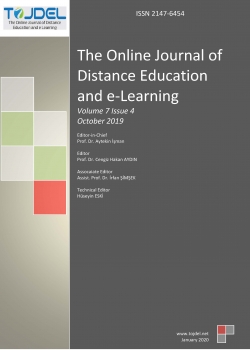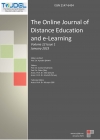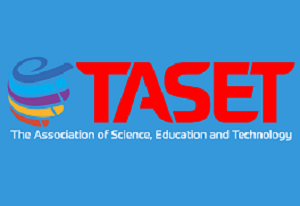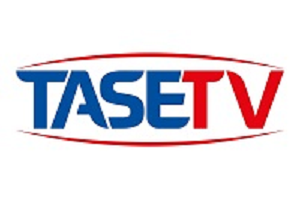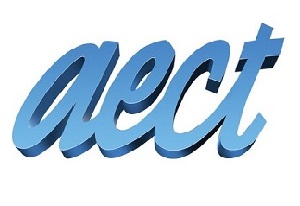TOJDEL - Volume 8 - Issue 1 - January 2020
 A STUDY ON PERCEPTION OF ACADEMICIANS TOWARDS ONLINE EDUCATION COURSES
A STUDY ON PERCEPTION OF ACADEMICIANS TOWARDS ONLINE EDUCATION COURSES Rajni Sofat, Rimple Sharma
Abstract:
The number of academicians enrolling for online courses has rapidly grown in last decade due to its merits. Besides having many merits, academicians are forming a pattern of perception and facing the problems which lead us in direction of research. The purpose of the study is to explore the factors which affect the perception and challenges of academicians towards online education courses. The study has been conducted in the time period of August 2018 to November 2018. A survey has been conducted and data has been collected through questionnaires from 100 academicians who are teaching at colleges & universities located in Jalandhar, Phagwara & kapurthala cities. Factor analysis has been applied to find out the factors which affect the perception and challenges of the academicians. From the analysis it has been interpreted that there are six factors which affect the perception of academicians i.e. Level of satisfaction, Performance with online mode, Abilities of instructor, learning from the course, Time period of course and Economical and in case of challenges, there are two factors which are becoming the barriers for the academicians i.e. Problem in accessing and Problem during performance.
 AN ACTION RESEARCH OF O2O BLENDED LEARNING IN THE INTEGRATED ENGLISH CLASS UNDER THE CONTEXT OF A CHINESE PRIVATE LANGUAGE UNIVERSITY
AN ACTION RESEARCH OF O2O BLENDED LEARNING IN THE INTEGRATED ENGLISH CLASS UNDER THE CONTEXT OF A CHINESE PRIVATE LANGUAGE UNIVERSITY Ling Li
Abstract:
Based on the framework of action learning, this study attempted to construct an online-to-offline (O2O) blended class of integrated English based on the flipped classroom, focusing on cultivating students' listening and speaking capability and critical thinking ability, improving students' competence to analyze and solve problems using English, and giving full play to students' personality characteristics. This action research spanned from February 2019 to June 2019. Taking the 130 students of integrated English class of College of International Business (CIB) of Zhejiang Yuexiu Foreign Languages University (ZYUFL) as samples, this paper adopted qualitative research methods, through the analysis of log observation and reflection reports, combining with comparisons of the quantitative online data. This paper drew the conclusion that the O2O blended learning based on flipped classroom in the integrated English class was the practice of innovative teaching mode and it created interactive classes of integrated English. It is suggested that if implemented from the beginning of freshman year, the continuation effect of this teaching mode should be better. In addition, if more teacher training opportunities were available, and if the teaching facilities and environment could be improved, the effect of this teaching mode should be more significant.
 BLENDED LEARNING IN HIGHER EDUCATION: A CRITICAL REVIEW
BLENDED LEARNING IN HIGHER EDUCATION: A CRITICAL REVIEW Subrahmanian Muthuraman, Rengarajan Veerasamy, Tajnuva Chowdhury Nabila
Abstract:
Advancements in technology has brought both opportunities and challenges to education and training. With technological innovations over the year’s reliance on the traditional face-to-face learning is being shifted on to other various means to support knowledge delivery and fostering an innovative learning environment. Instructional approaches such as Blended learning, which can combine face-to-face instruction with computer mediated instruction, has substituted a large portion of the traditional face-to-face instructional time. This paper aims to examine, and review of previous studies carried out based on the perceptions of students in blended learning environments and its effectiveness in enhancing the learning process. Desk Research technique was conducted for this study which basically involving collecting data from the existing online library. The main purpose of using desk research is to generate new insights from the previous studies. Reanalysing the previous literature may lead to unexpected new discoveries. Several case studies have been explored here which suggests blended learning has had positive impacts on improving student’s exam marks, attendance rate among others but, there is a need to consider that being fully dependent on it may result in reverse effects. As in contrast to this, studies also reveal that not everyone might be able to cope with the blended learning and might prefer a more traditional learning environment. And thus, it is necessary for higher educational institutions to pay obvious attention to the students’ individual learning needs and their views on blended learning. Higher Educational Institution may consider offering students a choice of whether to enrol in blended or fully face-to-face course sections where suitable. Educators should carefully design courses in ways with multiple means of expression and engagement, representation, to scaffold and support students in the creation of their own individualised blend. High degree of motivation, utility and satisfaction perceived from blended learning, which results in students to have a positive attitude towards learning.
 EFFECTS OF WEB 2.0 TECHNOLOGY ASSISTED SLIDESHARE, YOUTUB AND WHATSAPP ON INDIVIDUAL AND COLLABORATIVE LEARNING PERFORMANCE AND RETENTION IN TISSUES SYSTEM
EFFECTS OF WEB 2.0 TECHNOLOGY ASSISTED SLIDESHARE, YOUTUB AND WHATSAPP ON INDIVIDUAL AND COLLABORATIVE LEARNING PERFORMANCE AND RETENTION IN TISSUES SYSTEM Ananta Kumar Jena, Satarupa Bhattacharjee, Jaishree Devi, Munmi Barman
Abstract:
Web 2.0 tools includes wikis, blogs, social networking sites, and web applications for community interaction, inputs, content sharing, and collaboration. The study aimed to assess the effects of Web 2.0 technology assisted Slideshare, YouTube, and WhatsApp on the individual and collaborative learning performance and retention in tissues system. In this quasi-experimental research, there are three groups assigned for treatment in tissue system. Experimental group1 was exposed to web2.0 technology assisted individual Slideshare, Wiki, YouTube and WhatsApp modes of learning whereas Experimental group2 was treated with web2.0 technology assisted collaborative Slideshare, Wiki, YouTube and WhatsApp modes of learning, but lecture cum discussion intervention was provided to participants of traditional group. It was resulted there was significant effect of collaborative and individual web2.0 technology on the learning performance and retention of secondary school students over traditional group.
 FACTORS INFLUENCING E-LEARNING IMPLEMENTATION IN TANZANIAN UNIVERSITIES
FACTORS INFLUENCING E-LEARNING IMPLEMENTATION IN TANZANIAN UNIVERSITIES Simeo Kisanjara
Abstract:
Website design and optimization has become natural extension on learning in many universities nowadays as it moves learning materials to online in the name of e-learning. The said website design and optimization enhances the e-learning for the purpose of facilitating and providing flexibility in teaching and learning activities. However, the progress of e-learning implementation is yet to be adequate in many universities in developing countries including Tanzania. This study, investigated factors influencing e-learning implementation from broader dimensions. This study employed cross section survey design with quantitative approach using questionnaire for data collection. The study finding revealed that technological characteristics, user characteristics, pedagogical characteristics, social attributes and environmental characteristics significantly influence e-learning implementation level. Thus, this study contributes to the understanding of the new factors such as social, pedagogical and environmental which were inadequately addressed in the existing similar e-learning implementation models. Further, both factors were collectively used to develop a model for improving implementation of e-learning in Tanzanian universities and other countries with similar characteristics.
 QUALITY ASSURANCE TOOLKIT FOR ODL INSTITUTION: A REVIEW STUDY OF UTTARAKHAND OPEN UNIVERSITY
QUALITY ASSURANCE TOOLKIT FOR ODL INSTITUTION: A REVIEW STUDY OF UTTARAKHAND OPEN UNIVERSITY Jeetendra Pande, Alka Singh, Manas Ranjan Panighari, Karunesh Saxena
Abstract:
Accessible quality higher education system can have a multifaceted positive impacts at national as well as global level. In India, higher education is provided to the students through various ways including regular, distance and open learning modes. The Gross Enrolment Ratio (GER) in higher education in India is likely to increase in the coming years due to expansion of youth population in India. In such case, the Open and Distance Learning (ODL) Institutions has to play major role to ensure quality in teaching, learning, research and community participation.The purpose of the present paper is to assess, analyse and promote plans for further improvements and quality assurance of an ODL institute. One of the ODL institute, Uttarakhand Open University (UoU) was selected as sample for the present study. The data was collected through atoolkit developed by Commonwealth Educational Media Centre for Asia (CEMCA) for commonwealth Asia to engage ODL institutions to reflect on various aspects. The present review study includes leadership, governance, programme/course design, courseware/material development, learner admission and enrolment, academic and administrative support to learners, evaluation process, infrastructure facilities including ICT facilities, output/outcome quality, human resource and ambience of research.

